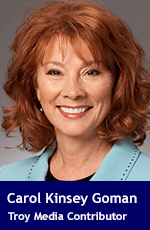 As a speaker at business conferences, I’ve addressed organizations around the world, and I’ve seen the genuine commitment that many companies have made to develop the leadership abilities of female employees and to create workplace environments with family-friendly policies and flexible work arrangements – all in hopes of attracting, retaining and grooming women for top management roles.
As a speaker at business conferences, I’ve addressed organizations around the world, and I’ve seen the genuine commitment that many companies have made to develop the leadership abilities of female employees and to create workplace environments with family-friendly policies and flexible work arrangements – all in hopes of attracting, retaining and grooming women for top management roles.
But despite this effort and this progress, far too many talented females still bump their heads on a glass ceiling.
In my book, The Nonverbal Advantage: Secrets and Science of Body Language at Work, I talk about the power of silent signals in the workplace. So I was fascinated to come across research that helps explain why even the best-intentioned efforts at developing women leaders are failing.
The research deals with emergent leadership in groups of equal status. And the findings have everything to do with body language.
 Research from the University of Delaware compared the nonverbal affect responses to male and female leaders and found that intellectual assertiveness by women in mixed-sex discussions elicits visible nonverbal cues of negative affect. Females taking a leadership role in the group received fewer pleased responses and more displeased responses from fellow group members than male leaders who spoke up and offered the same input.
Research from the University of Delaware compared the nonverbal affect responses to male and female leaders and found that intellectual assertiveness by women in mixed-sex discussions elicits visible nonverbal cues of negative affect. Females taking a leadership role in the group received fewer pleased responses and more displeased responses from fellow group members than male leaders who spoke up and offered the same input.
From earlier research, we know that displeased expressions by fellow group members cause a leader’s contribution to be rated less valuable than the identical contribution when embedded with cues of approval. So you can see how women’s ideas can be devalued simply by receiving less positive and more negative responses than men’s contributions of the same objective quality.
Here’s what can happen in a team meeting: A woman states her opinion. In response, negative nonverbal affect cues – frowns, head shakes, eye contact avoidance, etc. – are displayed, processed, and often mimicked by the entire group to produce a negative consensus about the value of her contribution. And all of this occurs without individuals on the team being aware of what’s happening.
At a time when conscious responses (direct answers on questionnaires, etc.) are becoming increasingly egalitarian, covert, unconscious responses still reflect discrimination against women taking a leadership role. Since hiring, salary, and promotion (especially to top leadership positions) often depend on being recognized as an emergent leader, this puts females at a distinct disadvantage.
Three key points:
1. This was a study of leadership behaviours in peer groups. There is no evidence suggesting that women in formal leadership roles generate any greater negative (or less positive) emotional cues than their male counterparts.
2. This was not about men discounting the contribution of women. The groups in the study had an equal mix of male and female members.
3. The power of nonverbal communication lies in its unconscious nature – and bringing the covert into awareness can help nullify its effect. (So, circulate this article!)
So, if you want to groom women for top positions in your organization, keep doing those things that have proven helpful: Offer females the coaching, mentors, and career opportunities that develop leadership potential.
But, in addition, pay attention to your own body language. Employees look for and emulate the nonverbal signals they get from their bosses. Current leaders can help create a level playing field for emergent leaders by providing the same cues of positive affect (eye contact, smiling, nodding, leaning forward, etc.) when listening to women as they do when listening to men.
Carol Kinsey Goman, PhD, is an executive coach, consultant, and international keynote speaker at corporate, government, and association events. She is also the author of STAND OUT: How to Build Your Leadership Presence. For interview requests, click here.
The views, opinions and positions expressed by columnists and contributors are the authors’ alone. They do not inherently or expressly reflect the views, opinions and/or positions of our publication.
© Troy Media
Troy Media is an editorial content provider to media outlets and its own hosted community news outlets across Canada.


